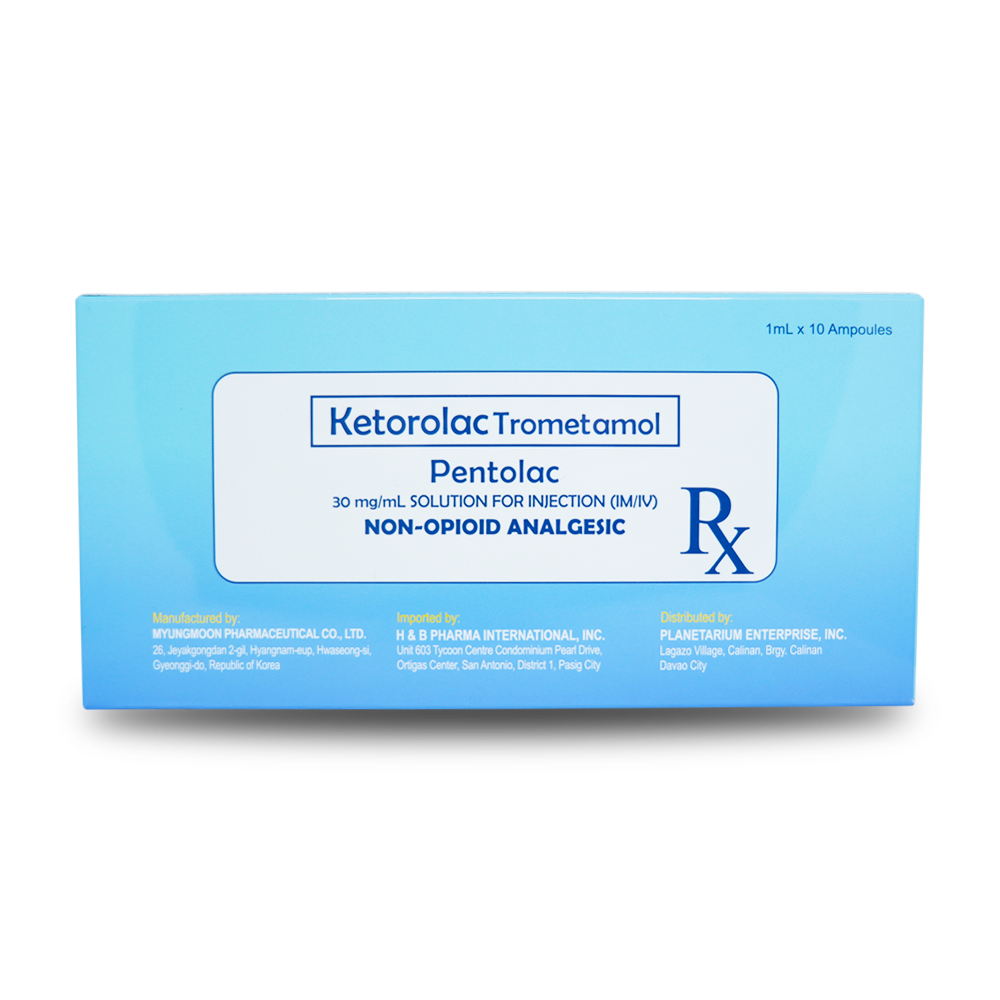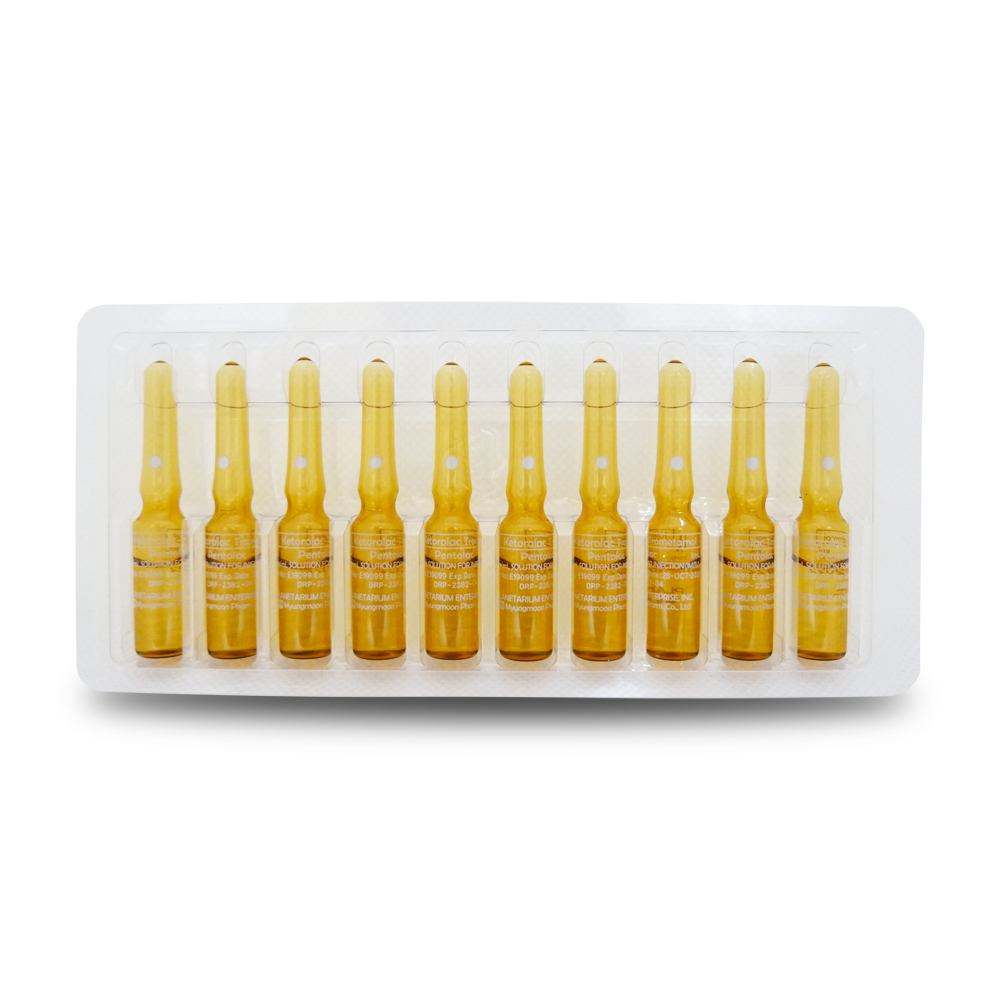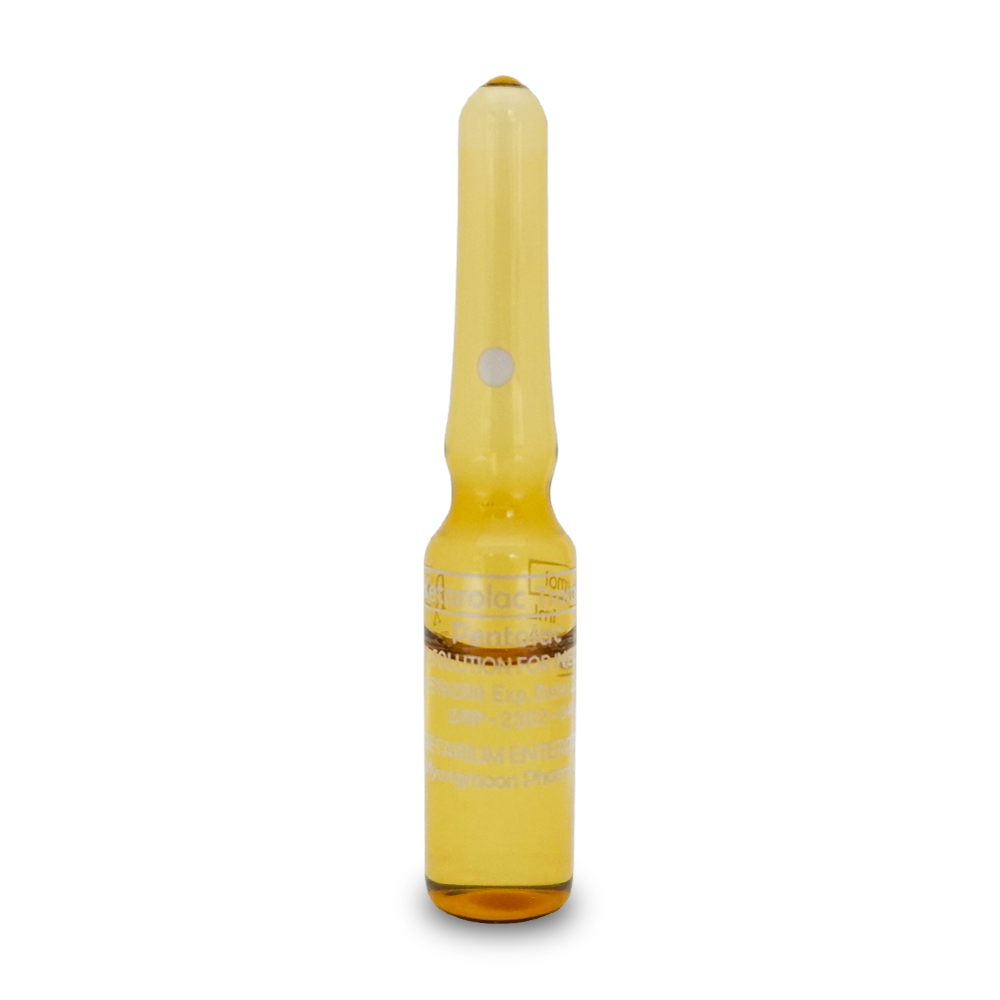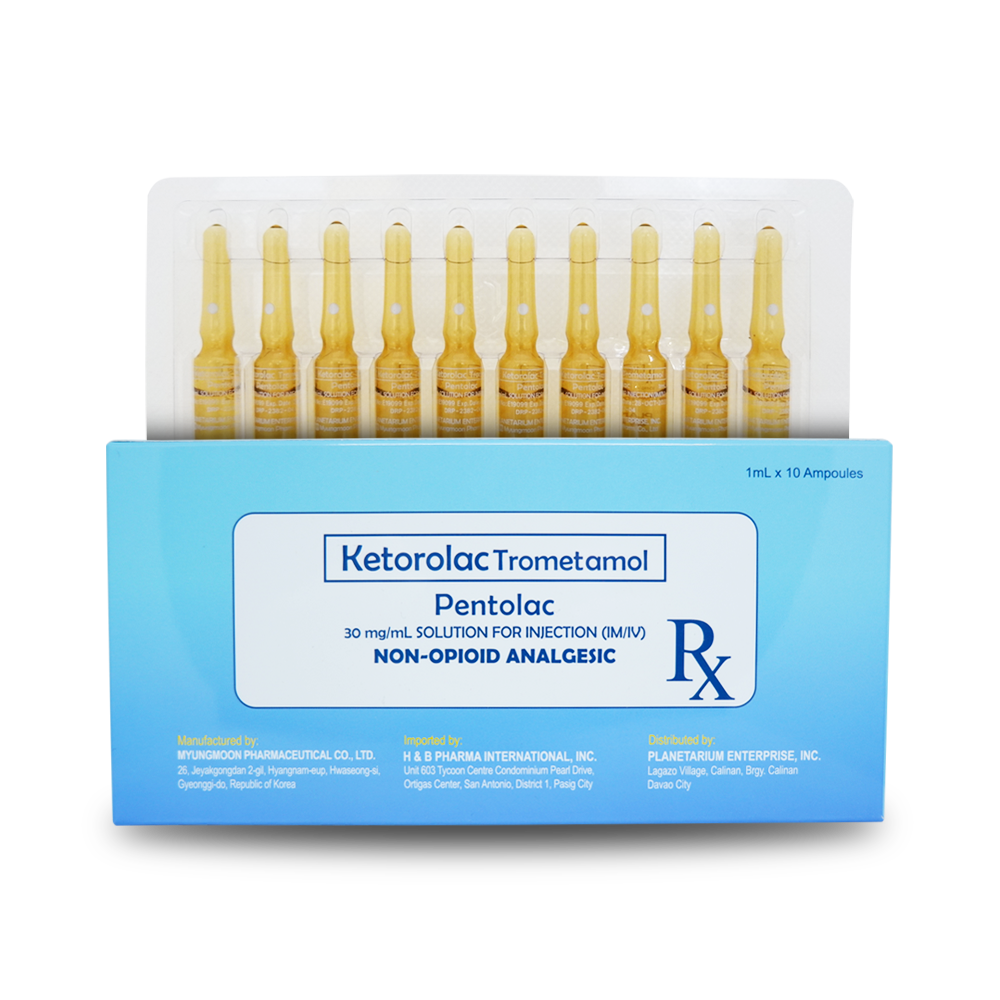



Generic Name: KETOROLAC TROMETAMOL
Pentolac
30 mg/ml Solution for Injection (IM/IV)
NON-OPIOID ANALGESIC
Formulation:
Each ml contains:
Ketorolac trometamol . ………………………….. 30 mg
Pharmacokinetics:
Ketorolac trometamol is absorbed after intramuscular or oral doses. At physiological pH, Ketorolac trometamol dissociates to form an ionic ketorolac molecule which is less hydrophilic than the trometamol salt. The peak plasma concentration of ketorolac is reached within about 30 to 60 minutes; absorption after intramuscular injection may be slower than after oral doses in some individuals. Ketorolac is over 99% bound to plasma protein. It does not readily penetrate the blood barrier. Ketorolac crosses the placenta and small amounts of drug are distributed into breast milk. The terminal plasma half life is about 4-6 hours but is about 6-7 hours in the elderly and 9 to 1 O hours in patients with renal dysfunction. The major metabolic pathway is glucoronic acid conjugation, there is some parahydroxilation. About 90% of a dose is excreted in urine as unchanged drug and conjugated and hydroxylated metabolites; the remainder is excreted in the faeces.
Indications:
Indicated for the short term management of moderately severe, acute pain at the opioid level.
Postoperative pain after general, orthopedic, gynecological and dental operation.
Pediatrics (2years of age and older): Severe postoperative pain that requires analgesia at the opioid level.
Dosage and Administration:
Adult
Ketorolac trometamol lV/IM is initiated with 10 mg, maintained with 10-30 mg every 4-6 hours and the minimum effective dose is used. Therapy should not to exceed 2 days. In elderly patients, patients with renal failure and patients below 50 mg of body weight, daily dose should not exceed 60 mg. Ketorolac trometamol is contraindicated for intrathecal or epidural administration. Based on incidence of symptoms or severity of the pain, amount of dosage and intervals are adjusted. Ketorolac trometamol is used concomitantly with morphine if necessary. Maximum duration of therapy is 5 days.
Children, 2 years of age and older
Single intravenous injection after pediatric operation. Thereafter, IV bolus can be given several times if necessary. In pediatric use, intravenous injection is recommended because of IM injection accompanying pain. Administer 0.5 mg/kg every 6 hours, if necessary, after 0.5-1.0mg/kg single dose. Therapy should not exceed 2 days. Based on incidence of symptoms or severity of the pain, amount of dosage and intervals are adjusted.
Or as prescribed by the physician.
Contraindications:
Ketorolac trometamol is contraindicated in patient with:
History of peptic ulcer, ulcer or perforation.
History of gastrointestinal bleeding.
Hemorrhagic diathesis, or a history of thereof.
Suspected or confinmed cerobrovascular bleeding.
Bronchial asthma or history of thereof.
Moderate or severe renal failure (serum creatinine > 160 mol/L)
Hypovolemia or dehydration.
Hypersensitivity to ketorolac tromethamine, aspirin or other NSAIDs.
Nasal polyp, vascular edema, or bronchial convulsion.
Patients took surgery with incomplete hemostasis or those at high risk of bleeding.
Pregnant women and nursing mothers.
Patients receiving other NSAIDs.
Patients taking anticoagulants, pentoxifylline. probenecid or lithium.
Patients taken tonsillotomy.
Pediatrics below 2 years of age.
Prophylaxis before major surgery.
Adverse Reactions:
GI : Nausea, dyspepsia, gastrointestinal pain, diarrhea, occasionally con s:,pation, flatulence, gastrointestinal fullness, vomiting, stomatitis, rarely peptic ulcer, gastrointestinal bleeding. perforation, hema’ec a, rectal bleeding, gastritis, ructus, anorexia, increased appetite, pancreatit,s may occur, increase blooa in urea & creatmrne.
Body as a whole : Occasionally edema, rarely anaphylaxis, bron cn•al convulsion, laryngeal edema, tongue edema, hypotension, rubedo, weight gain, fever, infections, asthenia may occur.
Cardiovascular: Hypertension, rarely rubed, palpitation, pallor, hypotension, syncope and flushing may occur.
Dermatologic : Flare, occasionally itching, rarely toxic epiderma, necrolysis (Lyell’s Syndrome), mucocutaneous ocular syndrome (Stevens Johnson Syndrome), exfoliative dermatitis, maculopapular rash, urticaria may occur.
Hemic and Lymphatic : Purpura, rarely postoperative wound hemorrhage, thrombocytopenia, epistaxis, anemia, leucopenia, and eosinophilia may occur and haematoma.
Nervous System : Headache, sweating, occasionally drowsiness. dizziness, rarely convulsions, vertigo, tremors, hallucinations, abdominal dreams, euphoria, extrapyramidal symptoms, paresthesia, depression, insomnia, nervousness, dry mouth, excessive thirst, abnormal vision, inability to concentrate, hyperkinesis, stupor may occur, fever and myalgia.
Hepatic : Rare hepatitis, liver failure, cholestatic Jaundice may occur. In the event of the symptoms, therapy should be immediately discontinued.
Respiratory : Rarely dyspnea, asthma, pulmonary edema, rhinitis, cough may occur.
Urogenital : Rarely acute renal failure, flank pain (with or without hematuria or azotemia), oliguria, nephritis, polyuria, increased urinary frequency, urinary retention may occur.
Others : Mental and sensory changes, aseptic meningitis, hyponatremia, hyperkalemia, nephritic syndrome & flank pain or without haematuria. Occasionally injection site pain, abnormal taste, abnormal vision, blurred vision, tinnitus, hearing loss may occur.
Precautions:
Ketorolac trometamol should be administered with care in patients with:
Depressed renal function or history of hepatic disease
History of renal disorder
Elderly Patients
Hypertension
Cardiac decompensation
Hypovolemia, dehydration or receiving diuretics
Congestive heart failure
Dehydration
History of gastrointestinal disease
Active gastrointestinal
Asthma
Nasal polyps
Hepatic impairment
Patients who consume more than 3 cups of alcoholic drink every day should not use this medicine or another antipyretic analgesic. They should consult physician before dosing. This drug may cause stomach bleeding in the patients.
When glass ampoule is broken, glass particles can be mixed with drug, and result in side effects. Therefore, ampoules should be cautiously broken to prevent contamination, and particularly caution is required in children’s use or, the old and weak person’s use.
Treatment should be started as IM or IV then changed to PO only as continuation treatment.
Total therapy should not exceed 5 days.
Dizziness may affect the performance skilled tasks such as driving.
Not given to patients with coagulation haemorrhage disorders.
Drug Interactions:
Binding of Warfarin to plasma proteins is only slightly reduced by ketorolac trometamol.
At therapeutic concentrations of salicylate (300 µg/ml), the binding of ketorolac was reduced form approximately 99.2% to 97.5%.
Therapeutic concentration of digoxin, warfarin, ibuprofen, naproxen, piroxicam, acetaminophen, phenytoin and tolbutamine did not alter ketorolac trometamol protein binding.
Patients on therapeutic doses of anticoagulants (e.g. heparin or dieumarol derivatives) have an increased risk of bleeding complications if given ketorolac trometamol concurrently. The concurrent use of ketorolac trometamol and prophylactic low-dose heparin (2500-5000 units q 12 h), warfarin and dextrans have not been studied extensively, but may also be associated with an increased risk of bleeding.
Ketorolac trometamol IV/IM reduced the diuretic response to furosemide in normavolemic healthy subjects by approximately 20%.
Inhibition of renal lithium clearance, leading to an increase in plasma lithium concentration, has been reported with some prostaglandin synthesis inhibiting drugs.
Concomitant administration of methotrexate and some SAIDs has been reported to reduce the clearance of methotrexate, enhancing the toxicity of methotrexate.
There have been reports of a possible interaction between ketorolac trometamol lV/IM and non depolarizing muscle relaxants that resulted in apnea.
Concomitant administration of ACE inhibitors may increase the risk of renal impainment, particularly in volume depleted patients.
Pregnant Women and Nursing Mothers:
There were no adequate and well controlled studies of ketorolac trometamol in pregnant women and nursing mothers. Therefore, Ketorolac trometamol is contraindicated in pregnant wor,en and nursing mother.
Use in the Elderly:
Because ketorolac trometamol may be cleared more so,•, y by the elderly who are also more sensitive to the adverse effects of NSAIDs, extra caution and reduced dosage must be usea \\nen treating the e deny with ketorolac trometamol lV/IM.
Overdosage:
In controlled overdosage, daily doses of 360 mg of ketorolac trometamol IV/IM given for 5 days (3 times e highest recommended dose), caused abdominal pain and peptic ulcers …,hich healed a’:er discontinuation of doses. Metabolic acidosis has been reported following intentional overdosage. Dialysis does not significantly c ear ketorolac trometamol from the blood stream.
Storage:
Store at temperatures not exceeding 30°C. Protect from light.
Caution:
Foods, Drugs, Devices and Cosmetics Act prohibits dispensing w hout prescription.
Availability:
Amber glass ampoule in transparent plastic tray x 1 ml ( Box of 1 O’s)
For suspected adverse drug reaction, report to the FDA: www.fda.gov.ph
location_on Lagazo Village, Calinan, Davao City
local_phone (082) 299 1768
phone_android +63 917 301 4186